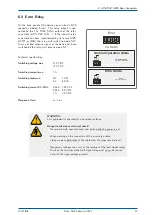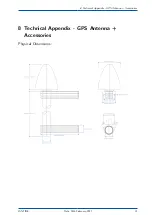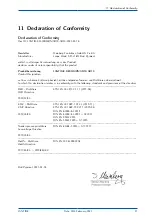
9 GPS satellite controlled clock with MRS option
9 GPS satellite controlled clock with MRS option
LANTIME/MRS is a Multi Reference Source time server. The reference time base, integrated into the LAN-
TIME, consists of a high precision oscillator OCXO HQ. This oscillator can be optionally controlled by the
integrated GPS receiver, an external Puls Per Second (PPS input), Standard Frequency Input (10MHz), an
IRIG time code receiver, by max. 7 external NTP servers or by a PTP IEEE 1588 Time Stamp Unit (M400,
M600 and M900 only).
In any case a OCXO oscillator is used as a reference for internal NTP, even if GPS reception or external
reference clock are not available. All outputs like serial output, PPS output or 10MHz will be driven by the
internal oscillator. The priority which reference clock will discipline the internal OCXO can be set up in a user
defined list via the display or the HTTP interface.
9.1 MRS Functionality
After power up the system the internal clock module will be free running on an internal oscillator. If the GNSS
receiver or one of the external reference sources are available and synchronized then the internal clock will be
set once and the internal OCXO will be adjusted. For the first time adjust with an external NTP server the
system will wait until the internal NTP has been synchronized and the time offset is below 1 ms (this will take
appr. 5 Min). After that the offset to the external NTP server will be calculated and set the internal clock
module. The following reference clocks are possible (depending on the expansions):
•
GNSS - GPS / GLONASS / Galileo / BeiDou receiver
•
IRIG time code receiver with DCLS or modulated
•
Pulse Per Second Input (PPS in)
•
up to 7 external NTP server
•
PTP IEEE-1588 (M400, M600 and M900 only)
•
Pulse Per Second plus serial time string (STR)
•
Freq. In.
If more than one reference clock is available and synchronized then the clock with the highest priority will
be taken to adjust the internal OCXO. This reference clock will be called master clock. If this master clock is
unavailable a different clock with the highest priority will be chosen. If a reference clock with a higher priority
than the current master will be available the master clock will be switched to the higher priority.
Each external reference source can be set with a bias (a fix offset), if you know the constant offset (bias)
of an external reference source. By default this value is 0 ns. The bias of the internal GNSS receiver can not
be set up - indirectly this can be done via the antenna cable length.
Each reference clock can be assigned a specific precision which will reflect the accuracy of the reference
clock. This precision value will determine the hold over time when switching to the next reference clock if the
current master is not available anymore. If the precision is set to 0 then the next reference clock will be switched
at once. If the precision value is greater then 0 the time for switching to the next reference (hold over time) will
be calculated by the following formula:
(precision of next reference) / (precision of current master) * constant [s]
The parameter "constant" depends on the quality of the internal oscillator.
Example:
the external PPS with an precision of 100ns is the current master. If this master is no longer
LANTIME
Date: 16th February 2021
37
Summary of Contents for LANTIME M300/MRS/AD10-AD10
Page 2: ......





































